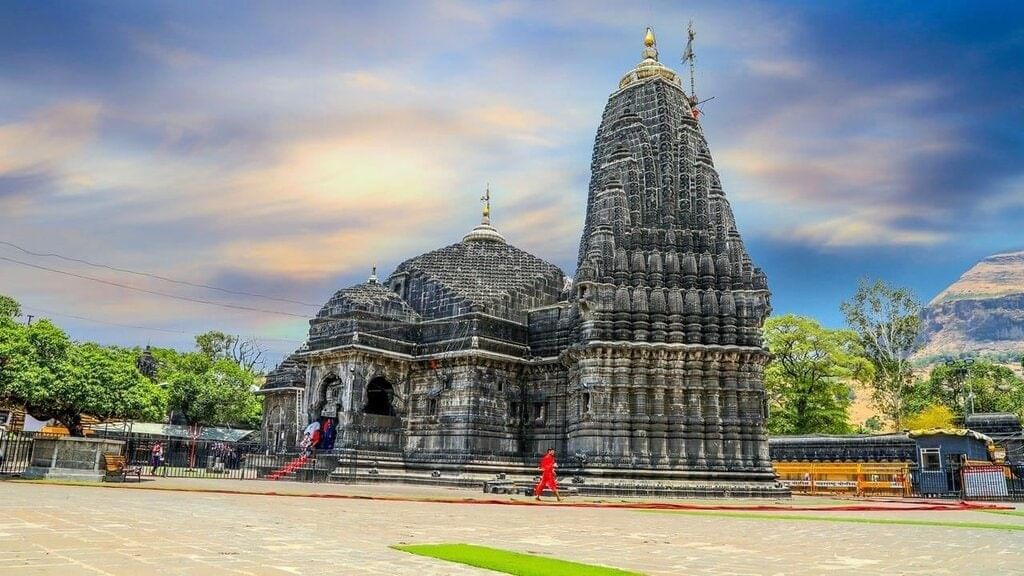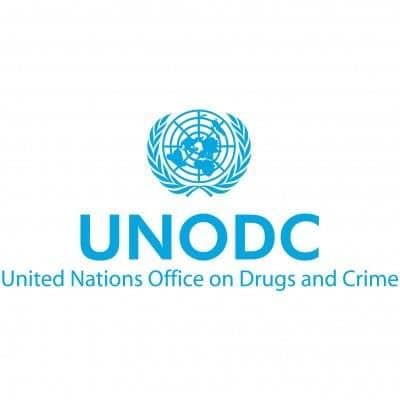UPSC Daily Current Affairs: 27th July 2025 | Current Affairs & Hindu Analysis: Daily, Weekly & Monthly PDF Download
GS1/History & Culture
Trimbakeshwar Shiva Temple
Source: Hindustan Times
 Why in News?
Why in News?Recently, the Nashik rural police uncovered a significant black-marketing operation involving darshan passes at the prestigious Trimbakeshwar Shiva Temple, highlighting the need for better regulation and oversight in religious tourism.
Key Takeaways
- The Trimbakeshwar Shiva Temple is dedicated to Lord Shiva and is located in Trimbak, Nashik district, Maharashtra.
- It is known as one of the twelve Jyotirlingas in India.
- The temple features a unique architectural style with intricate carvings and three lingams representing the Hindu trinity.
Additional Details
- About Trimbakeshwar Temple: This well-known Hindu temple is situated 28 km from Nashik, near the Brahamagiri mountain, which is the source of the Godavari River. Constructed by the third Peshwa, Balaji Bajirao, between 1740-1760, it stands on the site of an older temple.
- Architecture: The temple showcases a harmonious blend of traditional Hindu design and local artistic elements, featuring detailed carvings and sculptures that illustrate various mythological tales and deities. The complex also houses shrines dedicated to other gods and goddesses.
- Jyotirlingas: A Jyotirlinga is a shrine where Lord Shiva is worshipped in the form of a Jyotirlingam. There are 12 main Jyotirlingas in India, each symbolizing a different aspect of Lord Shiva.
- List of Jyotirlingas:The 12 Jyotirlingas include:
- Somnath Jyotirlinga in Gir, Gujarat
- Mallikarjuna Jyotirlinga in Srisailam, Andhra Pradesh
- Mahakaleshwar Jyotirlinga in Ujjain, Madhya Pradesh
- Omkareshwar Jyotirlinga in Khandwa, Madhya Pradesh
- Baidyanath Jyotirlinga in Deoghar, Jharkhand
- Bhimashankar Jyotirlinga in Maharashtra
- Ramanathaswamy Jyotirlinga in Rameshwaram, Tamil Nadu
- Nageshwar Jyotirlinga in Dwarka, Gujarat
- Kashi Vishwanath Jyotirlinga in Varanasi, Uttar Pradesh
- Trimbakeshwar Jyotirlinga in Nasik, Maharashtra
- Kedarnath Jyotirlinga in Rudraprayag, Uttarakhand
- Ghrishneshwar Jyotirlinga in Aurangabad, Maharashtra
The recent uncovering of the black-marketing racket has raised awareness about the importance of maintaining the sanctity of religious practices and ensuring fair access to devotees at the Trimbakeshwar Temple.
GS2/International Relations
What the Landmark U.K.-India FTA Really Means
Source: Business Today
Why in News?
Recently, India and the U.K. formally signed a Comprehensive Economic and Trade Agreement (CETA), marking the conclusion of negotiations that commenced in January 2022. This pact, finalized after over three years of extensive discussions, aims to significantly enhance bilateral trade and strengthen economic ties between the two nations.
Key Takeaways
- The U.K. will eliminate tariffs on 99% of its product lines, impacting approximately 45% of India's current exports, including textiles, footwear, automobiles, seafood, and fresh fruits.
- India will reduce duties on 90% of its tariff lines, covering 92% of U.K. exports to India, making British goods like whisky, cars, and engineering products more affordable for Indian consumers.
Additional Details
- Trade in Goods: The agreement offers substantial tariff reductions, with high-value exports from India, such as petroleum products and pharmaceuticals, already enjoying duty-free access in the U.K.
- Trade in Services: The CETA emphasizes services, allowing U.K. companies to operate in sectors like accounting and telecommunications in India without needing a local office.
- Double Contribution Convention (DCC): This agreement allows 75,000 Indian workers on short-term assignments in the U.K. to contribute solely to India’s social security system, avoiding double payments.
- Automobile Import Duties: For the first time, India will reduce import duties on cars, with duties on large-engine luxury cars dropping from 110% to 10% over 15 years, subject to quotas.
- Government Procurement: The U.K. will gain access to about 40,000 high-value Indian government contracts, particularly in transport and renewable energy sectors.
The India-U.K. trade agreement is still pending ratification by the Cabinets of both countries, a process expected to take between six months to a year. This agreement is not only significant in its own right but could also serve as a model for future trade negotiations with other major economies like the U.S. and the European Union.
GS3/Science and Technology
Foot and Mouth Disease (FMD)
Source: Hindustan Times
Why in News?
Recently, the deaths of 16 chitals, or spotted deer, at the Rajiv Gandhi Zoological Park in Pune have been confirmed to be due to Foot and Mouth Disease (FMD) following lab reports.
Key Takeaways
- FMD is a highly contagious viral disease affecting cloven-hoofed animals.
- It does not pose a threat to human health or food safety.
- The disease is transmitted through direct and indirect contact with infected animals.
Additional Details
- About Foot and Mouth Disease (FMD): FMD is caused by an aphthovirus from the family Picornaviridae and affects animals like cattle, sheep, goats, deer, and pigs. It is not related to the common childhood illness known as hand, foot, and mouth disease, which is caused by a different virus.
- Transmission: The virus spreads through direct contact with infected animals or indirectly via secretions (like milk and semen) and can also be carried by mechanical vectors such as people, vehicles, and even through air movement.
- Symptoms: FMD is characterized by symptoms such as fever, blister-like sores on the tongue and lips, lameness, and reluctance to eat. It can lead to severe production losses in livestock.
- Vaccination: Vaccines for FMD are available but need to be specific to the virus type causing the outbreak. There are seven known strains of the virus.
In conclusion, while the majority of infected animals can recover, FMD often leaves them weakened and can be fatal, especially in young animals. The disease remains a significant concern for livestock production and trade.
GS2/Polity
Working of Internal Complaints Committees
Source: The Hindu
Why in News?
A tragic incident in Balasore, Odisha, has brought attention to the functioning of Internal Complaints Committees (ICCs). A student committed self-immolation after her complaints of sexual harassment against the head of her department were dismissed by the college's ICC. Her family alleges that the committee was biased and lacked proper training, raising serious concerns about the effectiveness and neutrality of institutional grievance redressal systems.
Key Takeaways
- The ICC was established to address complaints of sexual harassment in educational and workplace settings.
- The POSH Act mandates the formation of ICCs in workplaces with more than 10 employees.
- Implementation of ICCs has been inconsistent, with criticisms regarding their training and effectiveness.
Additional Details
- Legal Framework Behind ICCs: The foundation for ICCs was established by the Supreme Court in 1997 through the Vishaka Guidelines. These guidelines were created in response to the gang-rape of Bhanwari Devi, a social worker in Rajasthan, and defined sexual harassment at the workplace. They mandated the creation of complaint committees led by women and involving external parties to ensure fairness.
- POSH Act: The Sexual Harassment of Women at Workplace (Prevention, Prohibition and Redressal) Act, 2013, made it mandatory for all workplaces with more than 10 employees to establish ICCs. It also allowed women in smaller or informal workplaces to seek redress through Local Committees formed by district authorities.
- Structure of ICC: Each ICC must be headed by a senior woman employee and include at least two internal members with relevant experience. Additionally, one external member is required, typically from an NGO, and at least half of the members must be women.
- Process of Filing Complaints: An aggrieved woman can submit a written complaint within three months of the incident. The ICC is required to complete its inquiry within 90 days and maintain strict confidentiality regarding the identities of all involved parties.
- Despite the framework, the implementation of ICCs remains poor, with the Supreme Court expressing concerns over enforcement and calling for immediate compliance. Activists have highlighted issues such as lack of training and confidentiality, leading to ineffective grievance redressal.
The recent case in Balasore underscores the need for properly structured and enforced ICCs to ensure they function effectively rather than serve as mere symbolic representations of compliance.
GS3/Economy
India's Insurance Sector - Projected Boom and Structural Shifts by 2030
Source: Storyboard18
Why in News?
India's insurance industry is set for significant growth, with Gross Written Premiums (GWP) anticipated to rise by 123% by 2030. This growth is attributed to evolving consumer behaviors, heightened insurance awareness, and structural changes in both retail and institutional segments. These insights are derived from a collaborative report by the Insurance Brokers Association of India (IBAI) and McKinsey & Company, which is further validated by the IBAI Insurance Insights Survey involving 2,500 retail customers.
Key Takeaways
- GWP is projected to increase from ₹11.2 lakh crore in 2024 to ₹25 lakh crore by 2030.
- Insurance penetration is expected to rise from 3.7% in 2024 to 5% by 2030.
- The retail segment will see substantial contributions from life insurance, while the institutional segment will focus on non-life insurance growth.
Additional Details
- Gross Written Premiums (GWP): GWP represents the total premium revenue collected by insurers from policies issued over a specific period, before any deductions. The anticipated growth signifies a robust increase in the total volume of insurance premiums.
- Insurance Penetration: This metric, defined as the ratio of total insurance premiums to a country's GDP, is expected to approach the global average of 6.8% by 2030.
- Retail Segment Insights: By 2030, retail GWP is expected to reach ₹21 lakh crore, primarily driven by life insurance. A significant opportunity exists among Ultra and High Net-Worth Individuals (UHNI and HNI) who represent 65% of the market potential.
- Institutional Segment Opportunities: Institutional GWP is projected to triple to ₹2.8 lakh crore by 2030, with the SME sector expected to become a key growth driver despite current low penetration.
This projected boom in the insurance sector highlights essential areas for regulatory reform and customer-centric innovations, which are crucial for enhancing insurance literacy and improving claims processes, particularly among SMEs and lower-income segments.
GS3/Environment
Discovery of New Bush Frogs in Meghalaya
Source: New Indian Express
 Why in News?
Why in News?Recently, two new species of bush frogs, named Raorchestesjadoh and Raorchestesjakoid, were discovered in Meghalaya, India. This discovery adds to the biodiversity of the region and highlights the importance of conservation efforts.
Key Takeaways
- Raorchestesjadoh was found in Langtor, Eastern West Khasi Hills at 1,655 meters above sea level.
- Raorchestesjakoid was discovered in Lawbah, East Khasi Hills at an elevation of 815 meters.
- Both species are part of the Raorchestes genus, which includes a total of 80 recognized species.
- These frogs are unique for their direct development, bypassing the tadpole stage.
Additional Details
- Habitat: Both species inhabit bushes and trees near human settlements, indicating their adaptability to altered environments.
- Evolutionary Significance: Their distinct calls, morphological features, and DNA sequences place them within the Raorchestesparvulus species complex, emphasizing their unique evolutionary paths.
- Geographical Range: The Raorchestes genus has a wide distribution, extending from southern and northeastern India to regions in Nepal, Myanmar, Thailand, Laos, and southern China, reaching as far as Vietnam, Cambodia, and western Malaysia.
This discovery underscores the rich biodiversity of Meghalaya and the need for continued research and conservation efforts in the region.
GS3/Science and Technology
NISAR Satellite - A Landmark NASA-ISRO Collaboration for Earth Observation
Source: Business Today
Why in News?
The Indian Space Research Organisation (ISRO) is preparing to launch the NISAR satellite from Sriharikota aboard a GSLV Mk-II rocket. This mission, which is a collaboration between NASA and ISRO, is set to take place on July 30 and is regarded as one of the most advanced Earth observation missions globally, with a budget of Rs. 12,000 crore and over a decade of development.
Key Takeaways
- NISAR is the first dual-band radar satellite for Earth observation.
- It combines NASA's radar technology with ISRO's engineering expertise.
- The satellite will monitor various environmental and disaster-related phenomena.
Additional Details
- Unique Features:NISAR is equipped with dual-frequency synthetic aperture radar (SAR), featuring:
- L-band radar (1.257 GHz): Suitable for penetrating dense forests and soil to assess subsurface movements.
- S-band radar (3.2 GHz): Optimized for surface-level observations, including crop growth and biomass estimates.
- Wide Coverage: The radar swath width is 240 km, with a spatial resolution of 3-10 meters, enabling precise tracking of phenomena such as land subsidence.
- Scientific Applications: NISAR supports research across six key themes, including solid Earth processes, ecosystems, and disaster response.
- India-Specific Enhancements: While NISAR will function globally, ISRO will operate the S-band radar over India to enhance applications in agriculture, forestry, and disaster management.
- Data Accessibility: NISAR will adopt an open-data policy, ensuring data availability typically within a few hours after acquisition.
In conclusion, NISAR represents a significant advancement in Earth observation technology, contributing to global scientific knowledge and supporting various applications critical for environmental monitoring and disaster response.
GS2/International Relations
United Nations Office on Drugs and Crime
Source: WHO
 Why in News?
Why in News?A recent report by the World Health Organization (WHO) and the United Nations Office on Drugs and Crime (UNODC) revealed that, over the past 90 years, contaminated medicines have resulted in the deaths of 1,300 individuals.
Key Takeaways
- The UNODC was established in 1997 through the merger of the United Nations Drug Control Programme and the Centre for International Crime Prevention.
- It plays a critical role in combating illicit drugs and international crime while also addressing terrorism.
Additional Details
- Functions of UNODC:
- Educates the global community about the dangers of drug abuse.
- Strengthens international cooperation against illicit drug production and trafficking.
- Improves crime prevention and assists with criminal justice reform.
- Addresses transnational organized crime and corruption.
- Terrorism Prevention Branch: In 2002, the UN General Assembly expanded its activities, focusing on assisting states in ratifying and implementing legal instruments against terrorism.
- Funding: The UNODC primarily relies on voluntary contributions from governments to fund its operations.
- Headquarters: The office is located in Vienna, Austria.
This information underscores the ongoing challenges posed by contaminated medicines and the critical work undertaken by the UNODC in various areas, including drug control and international crime prevention.
GS2/International Relations
Global Specs 2030 Initiative
Source: Indian Express
Why in News?
The World Health Organisation (WHO) has launched the Global Specs 2030 initiative, aimed at ensuring universal access to affordable eyecare services by the year 2030.
Key Takeaways
- The initiative focuses on improving access to refractive services.
- It aims to build the capacity of eye care personnel.
- Public awareness about eye health will be promoted.
- The initiative seeks to reduce the cost of eyeglasses and services.
- Strengthening data collection and research in eye care is a priority.
Additional Details
- Normative Work: This aspect builds on WHO’s existing technical guidance and aims to develop additional resources for eye care.
- Global SPECS Network: This network serves as a platform for organizations to engage in coordinated advocacy, share experiences, and expand their professional networks.
- Private Sector Dialogues: These discussions will involve relevant players from the optical, pharmaceutical, and technology sectors, including service providers and insurance companies.
- Regional and Country Engagement: Various activities will be conducted to accelerate progress and bridge the gap between global commitments and local implementation.
The Global Specs 2030 initiative is a comprehensive strategy that seeks to address the critical need for accessible eyecare services worldwide, ensuring that no one is left behind in accessing essential eye health solutions.
GS3/Environment
Horsehair Worms: Recent Discoveries
Source: ETV Bharat
Why in News?
Officials from the Forest Department have recently discovered Horsehair worms, scientifically known as Nematomorpha, in the Motidol beat area of the Mohandra region, part of the Southern Forest Division within the Panna Tiger Reserve.
Key Takeaways
- Horsehair worms, also referred to as Gordian worms, belong to the phylum Nematomorpha.
- They can grow to lengths ranging from several inches to over 14 inches.
- These worms are quite thin, measuring between 1/25 inch to 1/16 inch in width (1 mm to 1.5 mm), and maintain a uniform diameter.
- Color variations include whitish, yellow/tan, brown, and black.
- They are typically found in water sources like ponds, rain puddles, swimming pools, and even domestic water supplies.
Additional Details
- Life Cycle: Adult Horsehair worms are free-living and non-parasitic, while their immature stages are internal parasites that affect insects such as grasshoppers, crickets, and cockroaches.
- These worms are not parasites of humans, livestock, or pets and pose no threat to public health.
- They are considered beneficial as they help control populations of certain insects.
In summary, the presence of Horsehair worms in the Panna Tiger Reserve highlights the biodiversity of the region and their ecological role as natural pest controllers.
GS2/Polity
Kargil Vijay Diwas
Source: The Hindu
 Why in News?
Why in News?On the occasion of the 26th anniversary of Kargil Vijay Diwas, the President and Prime Minister of India led the nation in honoring the brave soldiers who sacrificed their lives during the Kargil War.
Key Takeaways
- Kargil Vijay Diwas is celebrated every year on July 26 to commemorate India's victory in the Kargil War against Pakistan.
- The year 2025 marks the 26th anniversary of this significant event.
Additional Details
- Kargil War: The conflict took place between India and Pakistan from May to July 1999 in the Kargil district of Kashmir along the Line of Control (LOC).
- Causes: Following the Lahore Declaration in February 1999, aimed at resolving tensions over Kashmir, Pakistani forces secretly infiltrated the Indian territory during the winter of 1998-1999.
- Operation Vijay: The Indian Army launched 'Operation Vijay' to reclaim strategic positions, including the famous 'Tiger Hill.'
- High Altitude Warfare: The war was fought at extreme altitudes, with battles occurring at heights exceeding 18,000 feet.
- Casualties: Approximately 500 Indian soldiers and around 1,000 Pakistani troops lost their lives during the conflict.
The Kargil War concluded on July 26, 1999, marking a significant moment in India's military history. The sacrifices made by the soldiers are commemorated annually, reminding the nation of their valor and dedication to protecting India's sovereignty.
|
38 videos|5288 docs|1117 tests
|
FAQs on UPSC Daily Current Affairs: 27th July 2025 - Current Affairs & Hindu Analysis: Daily, Weekly & Monthly
| 1. What is the significance of the Trimbakeshwar Shiva Temple in Hindu culture? |  |
| 2. How does the U.K.-India Free Trade Agreement (FTA) impact trade relations? |  |
| 3. What are the implications of Foot and Mouth Disease (FMD) on livestock and agriculture? |  |
| 4. What is the role of Internal Complaints Committees (ICCs) in addressing workplace harassment? |  |
| 5. What trends are projected for India’s insurance sector by the end of the decade? |  |
















